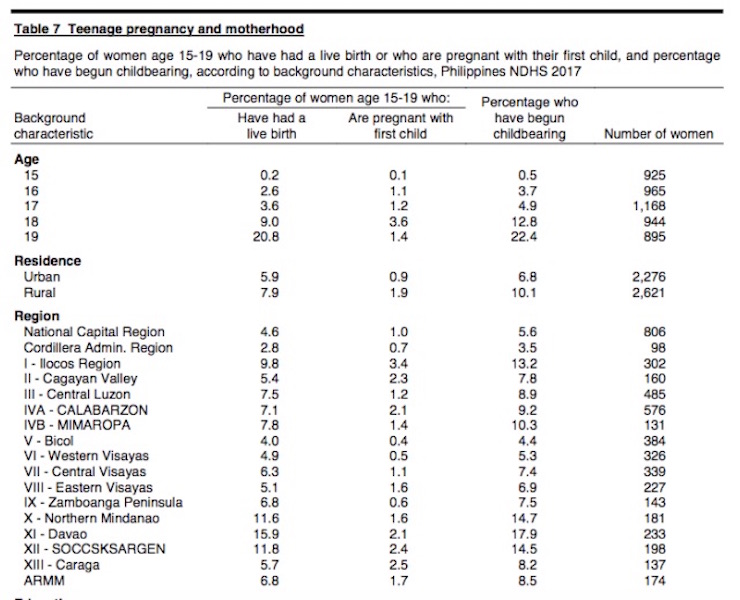DAVAO CITY (MindaNews / 01 July) — Teenage pregnancy in the country is highest in three of Mindanao’s six regions.
Davao region recorded the highest teenage pregnancy rate nationwide at 17.9%, Northern Mindanao at 14.7% and Region 12 or what is also referred to as Southwestern Mindanao or Soccsksargen at 14.5% compared with the national average of 8.6%, the 2017 National Demographic and Health Survey (NDHS) showed.
The result of the survey, administered on women aged 15 to 19 years old who have had given birth or were pregnant with their first child, was released by the Philippine Statistics Authority (PSA) regional office here on Saturday.
The number of teenage pregnancies in the five-province, six-city Davao region is almost double the national average.
 Source: National Demographic and Health Survey 2017
Source: National Demographic and Health Survey 2017
At least 16% of the teenage women who have begun childbearing have had live birth and 2% were pregnant with first child at the time of the survey.
Davao region comprises the provinces of Davao Del Norte, Davao Oriental, Davao del Sur, Davao Occidental and Compostela Valley and the cities of Davao, Digos, Panabo, Samal, Tagum and Mati.
The survey noted that two other Mindanao provinces — Northern Mindanao (14.7%) and Region 12 Soccsksargen (14.5%) placed second and third highest, respectively.
Northern Mindanao comprises the provinces of Bukidnon, Camiguin, Lanao del Norte, Misamis Oriental and Misamis Occidental and the cities of Malaybalay, Valencia, Cagayan de Oro, Iligan, Tangub, Oroquieta and Ozamiz.
Region 12 comprises South Cotabato, North Cotabato, Sarangani, Sultan Kudarat and the cities of Koronadal, General Santos, Kidapawan, Tacurong and Cotabato.
While the three Mindanao regions post the highest in teenage pregnancy, the three other regions recorded lower than the national average: 7.5% in Zamboanga Peninsula, 8.2% in Caraga, and 8.5% in the Autonomous Region in Muslim Mindanao.
Nationwide, the Cordillera Administrative Region posted the lowest at 3.5%.
Of the 25,074 women surveyed for the NDHS, at least 5,120 were teenagers from 15 to 19 years old.
The NDHS was “designed to provide indicators on fertility, fertility preferences, family planning practice, childhood mortality, maternal and child health, knowledge and attitude regarding HIV/AIDS, and violence against women.”
“These indicators are crucial in policymaking, program planning, and monitoring and evaluation of population and health programs, including those anchored on the attainment of related Sustainable Development Goals ,” it added.
The survey also found that 62.2% of married women were currently using contraception in the Davao, higher compared to 53.8% recorded in the NDHS 2013; 48.9% of the contraceptive users rely on modern method and 13.2% on traditional method; and 37.8% of married women reported not using any method of contraception.
It added the “use of modern method increased by 25 percent from the previous NDHS survey round.”
The PSA said the pill remained the most used modern method of contraception at 28.1%; 6.5% female sterilization and 5.9% IUD; and 9% of married women used withdrawal as traditional method of contraception. (Antonio L. Colina IV / MindaNews)
